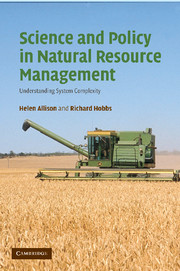Book contents
- Frontmatter
- Contents
- List of illustrations
- List of tables
- Foreword
- Preface
- Acknowledgements
- List of abbreviations
- 1 Introduction
- 2 Historical and policy context
- 3 Natural resource degradation: a resistant problem of the twentieth century
- 4 The epistemology of natural resource management of the twentieth century
- 5 A contemporary epistemology and framework for natural resource management of the twenty-first century
- 6 Model conceptualisation of the Western Australian agricultural region. Part 1: resilience analysis
- 7 Model conceptualisation of the Western Australian agricultural region. Part 2: system dynamics
- 8 Synthesis
- Epilogue
- Glossary
- References
- Index
3 - Natural resource degradation: a resistant problem of the twentieth century
Published online by Cambridge University Press: 01 March 2010
- Frontmatter
- Contents
- List of illustrations
- List of tables
- Foreword
- Preface
- Acknowledgements
- List of abbreviations
- 1 Introduction
- 2 Historical and policy context
- 3 Natural resource degradation: a resistant problem of the twentieth century
- 4 The epistemology of natural resource management of the twentieth century
- 5 A contemporary epistemology and framework for natural resource management of the twenty-first century
- 6 Model conceptualisation of the Western Australian agricultural region. Part 1: resilience analysis
- 7 Model conceptualisation of the Western Australian agricultural region. Part 2: system dynamics
- 8 Synthesis
- Epilogue
- Glossary
- References
- Index
Summary
I'm truly sorry man's dominion, Has broken nature's social union
Robert Burns, 1785Introduction
The ultimate responsibility for achieving sustainable natural resource management resides with the government. It is the government's responsibility to establish the policy, legislation and administrative structures, which was discussed in Chapter 2, to enable and facilitate the community's sustainable use of natural resources. The primary responsibility for the management and use of natural resources remains a matter for the owners of the natural resources, consistent with government policy. Within any framework of policies and institutions for land management it is land managers who have the responsibility to interpret government policy in order to implement actions to meet policy objectives. Land managers have the most direct impact on the quality of natural resources through their management practices.
Within the framework of policies the traditional approach by governments to land management was command and control policy (CCP), which was largely replaced by integrated natural resource management approaches in the 1980–90s. The Landcare movement of the 1990s was responsible for information transfer on sustainable land management practices and persuading agricultural producers of the need for change (Cary et al., 2002). However, the policy framework was unable to satisfactorily address long-term and large-scale natural resource problems.
Agricultural producers are keen to adopt new practices that yield greater short-term returns. In most cases these increased returns do not fully account for the long-term detrimental effects on the natural resources affected by their use (van Bueren and Pannell, 1999; Pannell et al., 2001).
- Type
- Chapter
- Information
- Science and Policy in Natural Resource ManagementUnderstanding System Complexity, pp. 40 - 50Publisher: Cambridge University PressPrint publication year: 2006



